- Step-by-step Scenario showing you how to edit constraints defined in the Sketcher.
- Modifying Constraint Values by Using the Shift Key
- About Diameter and Radius Constraints
- Deactivating or Activating Constraints
-
Double-click Sketch1 as the sketch to be edited.
You are now in the Sketcher workbench.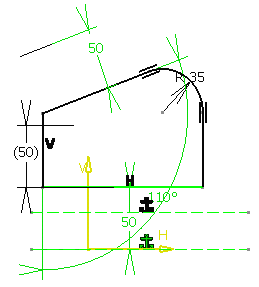
-
Double-click the Radius.6 constraint.
The Constraint Definition dialog box appears.
-
Select the Reference option to make the constraint a reference.
The Radius field is deactivated, indicating that the value is now driven by modifications to the sketch.
Using the Reference mode, the offset value is displayed between brackets indicating this mode and measured from the component locations. When the offset constraint supporting elements are two non-parallel lines or the offset constraint is over-constrained, the offset value cannot be measured, the constraint is invalid, any value is displayed and two pound signs are displayed between the brackets (##).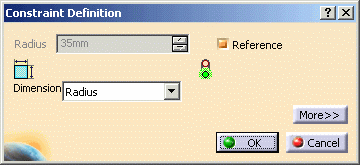
-
Click OK to confirm.
The radius value is displayed in brackets in the geometry area.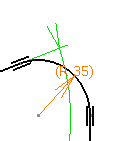
If you drag the corner center point, you can check that the radius value is updated.
-
Double-click the Angle.9 constraint.
The Constraint Definition dialog box appears.
-
Type 125deg and click OK.
The new value is displayed in the geometry area. It affects the angle. The sketch shape is also modified due to the radius previously converted into a measure.
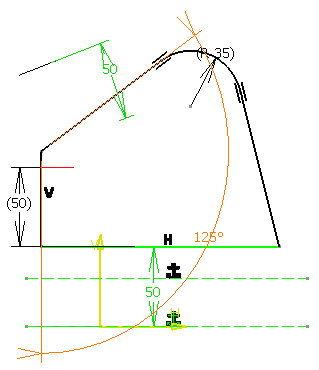
-
Double-click the Offset.14 constraint.
The Constraint Definition dialog box appears.
-
Click the More button to access additional information.

-
Click the Line.5 component.
The related geometry is highlighted.
-
Click Reconnect... to redefine the constraint component.
-
Select Line.6 and type 52mm in the Value field.
-
Click OK.
The position of the profile is modified accordingly.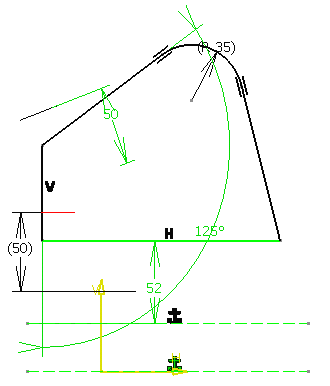
-
Exit the Sketcher.
The application has integrated the modifications to the sketch.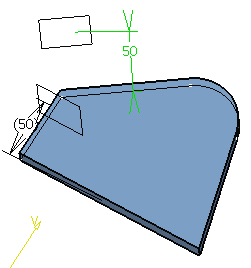
-
Double-click Offset.3.
The Constraint Definition dialog box appears. -
Type 30mm in the Value field and click OK.
The offset is modified accordingly.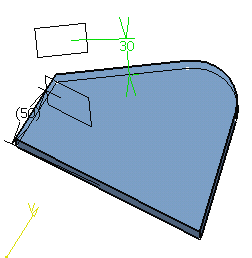
Modifying Constraint Values by Using the Shift Key
It is possible to edit dimensional constraint values just by dragging constrained geometry. This is a quick way of editing constraints without launching dialog boxes.
-
Press the Shift key and drag the vertical line to the right as shown below.
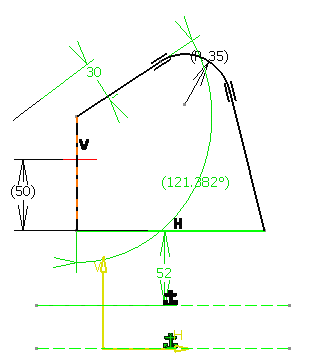
You can notice that the value of the angle constraint is not only modified as you are dragging the cursor, but it is also displayed between parentheses, meaning that it is temporarily converted into a reference. In other words, you can move the geometry freely, with respect to geometrical constraints.
-
Press the Shift key and drag the vertical line to the right as shown below.
The modified angle value is displayed (137.913), and is no longer a reference:
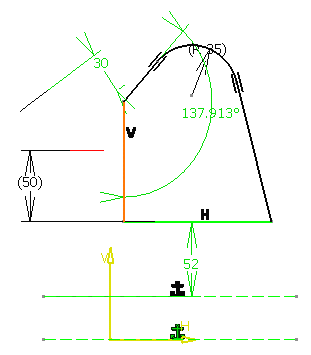
If the Snap to Point
![]() option is active, the geometry is moved according to the spacing you
defined for the grid. For more information, refer to the customization for
Sketcher).
option is active, the geometry is moved according to the spacing you
defined for the grid. For more information, refer to the customization for
Sketcher).
About Diameter and Radius Constraints
-
You can obtain a radius constraint by editing a diameter constraint. You just need to double-click the diameter constraint and choose the radius option in the dialog box that appears.
-
If you need to create a formula remember that:
-
the parameter corresponding to the radius or diameter constraint is referred to as RadiusX.object
-
this parameter always contains the radius value. As a consequence you can only add a formula on the
radius, not on the diameter (the diameter is a way to display the constraint, not the parameter itself).
For more information about formulas, refer to Knowledge Advisor User's Guide.
-
- You can add a formula to the radius value of a diameter constraint by using Tools > Formula.
Deactivating or Activating Constraints
You can:
- deactivate a constraint by right-clicking it and selecting
XXX.N.object > Deactivate. In other words, this constraint will
still appear on the sketch but will not behave as such.
Deactivated constraints appear preceded by an open-close brackets symbol in the geometry and in the specification tree.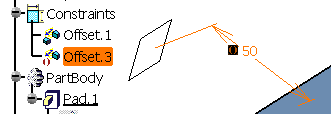
- activate a constraint, use the Activate option from the contextual menu.